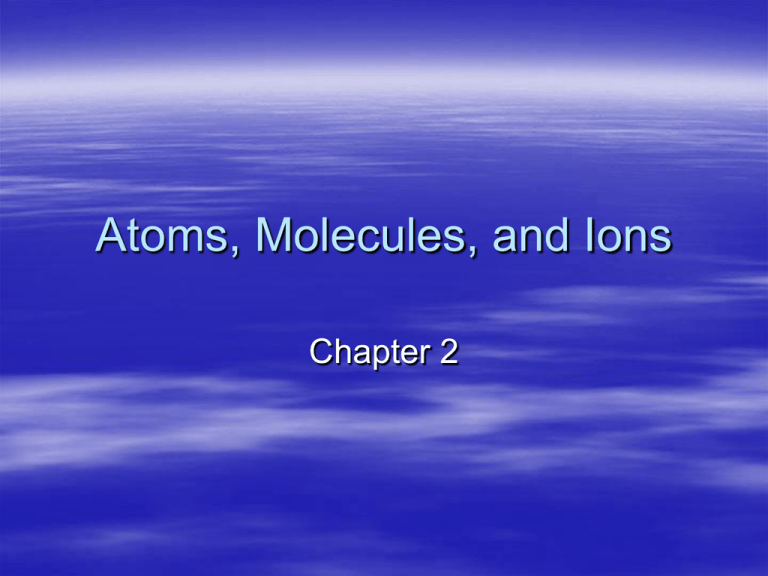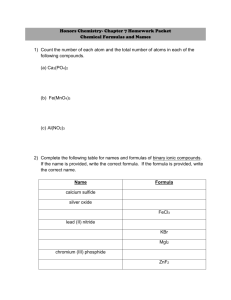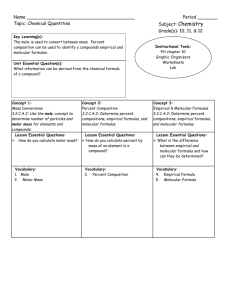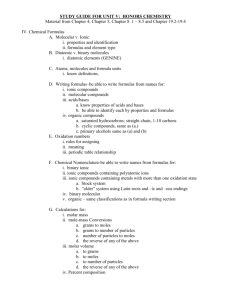notes ch2.6-2.11 Atoms, Molecules, and Ions
advertisement

Atoms, Molecules, and Ions Chapter 2 2.6 Molecules, Compounds, and Formulas A molecule is the smallest identifiable unit into which a pure substance can be divided and still retain the composition and chemical properties of the substance. Molecules, Compounds, and Formulas How do molecules differ from their composite elements? molecular formula – gives composition (ex. Ethanol C2H6O) condensed formula – elements are written as groups (CH3CH2OH) structural formula – shows how elements are attached Molecular Models ball and stick model space filling model 2.7 Ionic Compounds: Formulas, Names, and Properties ionic compounds consist of charged atoms, or ions cations and anions – metals generally lose electrons – nonmetals generally gain electrons Ions monatomic – How can you determine charge? Group A elements have predictable patterns of behavior, but Group B elements do not! polyatomic ions – see chart p 74 in book – MEMORIZE!! Ionic Formulas and Names cation is written first followed by the anion; use parentheses if more than one polyatomic ion is present name of the metal plus the word “cation” – Ba+2 is barium cation if metal can form more than one ion, then use Roman numerals to indicate the charge – Hg+ is mercury (I) Ionic Formulas and Names the ending on an anion is changed to –ide – F- is fluoride (halide ions) polyatomic ions keep their ending – SO4-2 is sulfate (oxoanions) – prefixes tell how much oxygen is present – Chlorine oxoanions are good examples! Properties of Ionic Compounds electrostatic forces hold ions together – force of attraction or repulsion between ions is Coulomb’s law The force between two charged particles is proportional to the magnitude of the charges (attraction between ions increases as ion charge increases) The force is inversely proportional to the square of the distance (attraction decreases as distance between the ions increases). Properties of Ionic Compounds ionic compounds are three dimensional arrays of atoms called a crystal lattice high melting points due to the great attraction between ions 2.8 Molecular Compounds: Formulas, Names, and Properties can be gases, liquids, or solids The first nonmetal is named, the second is named with an –ide ending. – HCl hydrogen chloride The number of atoms of a given type is indicated by using a prefix. – N2O dinitrogen monoxide Some have common names – CH4 methane 2.9 Atoms, Molecules, and the Mole The mole is the chemical unit measuring amount of substance. 1 mole = 6.0221415 x 1023 particles – Avogadro’s number molar mass is the mass in grams of one mole of an element (g/mol) Atoms, Molecules, and the Mole use the formula of a compound to determine the molar mass use molar mass to convert to moles (amount) use molar mass to convert to molecules 2.10 Describing Compound Formulas Molecular composition – formula of compound – mass of each element per mole of compound – mass of each element relative to the total mass of the compound (mass percent) Empirical and Molecular Formulas convert mass percent to mass convert mass of each element to moles find the mole ratio of elements the simplest, whole-number ratio is the empirical formula If the molar mass is determined experimentally, then you can also figure out the molecular formula. Practice Problems The empirical formula of acetic acid is CH2O. If its molar mass is 60.05 g/mol, what is the molecular formula of acetic acid? Isoprene is a liquid compound that can be polymerized to form synthetic rubber. It is composed of 88.17% carbon and 11.83% hydrogen. Its molar mass is 68.11 g/mol. What are its empirical and molecular formulas? Practice Problems Camphor is found in “camphor wood,” much prized for its wonderful odor. It is composed of 78.90% carbon and 10.59% hydrogen. The remainder is oxygen. What is its empirical formula? Analysis shows that 0.586 g of potassium metal combines with 0.480 g of O2 gas to give a white solid having a formula of KxOy. What is the empirical formula of the compound? Hydrated Compounds Compounds in which molecules of water are associated with the ions of the compound are called hydrated compounds. – Copper (II) chloride dihydrate is CuCl2∙2H2O which is the same as CuCl2(H2O)2 anhydrous means a substance without water Homework for Chapter 2 After reading sections 2.6 – 2.11, you should be able to do the following problems… P. 107 (112-121)




